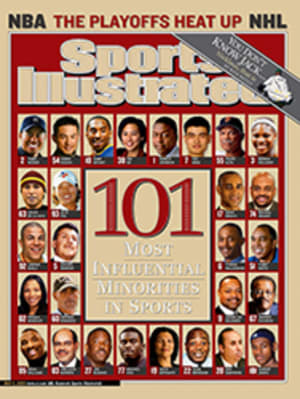
Balk Like an Egyptian Forget Abner Doubleday, Alexander Cartwright and that rounders theory--the seeds of our national pastime were planted four millennia ago on the banks of the Nile
Peter Piccione translates hieroglyphs for his history students
the way a horror-movie archaeologist deciphers ancient curses
from sarcophagi--slowly and portentously. During slide
presentations at the College of Charleston, he'll run through
images ranging from papyrus paintings to the Pittsburgh Pirates
before posing a question seemingly out of leftfield: "Did the
Egyptians invent baseball?"
It's a rhetorical question for Piccione. For years this
51-year-old academic sleuth has investigated the mysteries of
seker-hemat, a bat-and-ball game that predated Wee Willie Keeler
and Big Train Johnson by at least four millennia. Piccione's
seminal lecture lures crowds far outside Charleston--he's given
his baseball talk in Chicago, Dallas and Cooperstown; this month
he's booked at Emory University in Atlanta--and the way he tells
it, the original sandlot was the Sahara. And the top hitter of
1475 B.C. was the pharaoh Thutmose III, a Near Eastern Leaguer as
immortal as Babe Ruth.
Academics have long batted around theories of baseball's origins.
Our national pastime has been traced to age-old games played in
England, France, Germany, Libya and Spain. One 10th-century Norse
variation, knatteleik, was a dawn-to-dusk affair in which Viking
batters swung at balls of leather or wood. (No, the batting
helmets weren't horned.) "The Abner Doubleday myth dies hard,"
says Tim Wiles, director of research at the Hall of Fame. "But we
no longer think the sport had a single inventor. It has evolved
over many, many years."
An authority on ancient Egypt for three decades--his doctoral
dissertation decoded the rules of the Egyptian board game senet,
a distant uncle of Parcheesi--Piccione is the first scholar to
propose that baseball grew out of a Pharaonic fungo. By decoding
reliefs and texts on the walls of temples, the Brooklyn-born
Egyptologist has determined that the really old ball game was
played by kings during the festivals of certain goddesses and in
front of the statues of deities. References to seker-hemat
(roughly, "batting the ball") go back 4,400 years. In Piccione's
reading of Pyramid Texts Spell 254, gods command a pharaoh to
cross the heavens and "strike the ball" in the meadow of the
sacred Apis bull.
A thousand years later, at the shrine of the love goddess Hathor
in Deir-el-Bahari, Thutmose III was depicted playing pepper
(above). In one hand T-3, as Piccione calls him, brandishes a
sort of Memphis Slugger; in the other, a ball resembling the
stitched leather orbs that have been found in excavations. Two
priests, arms upright, grasp balls in their hands. The
inscription: "Catching it for him by the servants of god."
The aim of the game, Piccione reckons, was to swat at and destroy
the evil eye of Apopi, the serpent of chaos. Though it's unclear
if T-3 was a designated Hittite, the professor suspects
seker-hemat involved umpires, baserunning ("Running was a big
part of Egyptian games" ) and huge crowds. "Who wouldn't want to
see the Pharaoh beat Apopi?" Piccione asks.
Until excerpts of Piccione's work made it into the Hall of Fame
library, the most convincing document in the Hall that linked the
Red Sox to the Red Sea was a clipping from the Weekly World News.
The story claims that a pyramid game was played by two six-man
teams using a ball made of tightly wrapped palm fronds and that
outfielders hurled daggers at runners who rounded second and
tried to score. "I guess that was the first twin killing," cracks
Wiles.
The father of the father of the father of the father of the
father ... of the modern game is on exhibit, but not in
Cooperstown. He's in the Cairo Museum. "T-3 is a muscular mummy,
maybe 5'7"," Piccione says. "He was a Hall of Fame military man
with 37 victories in 37 campaigns. Like Roberto Clemente, he was
heroic. Like Brooks Robinson, he had a good disposition. Like Ty
Cobb, he took no guff. And like Joe DiMaggio, he wears his
wrappings nattily." --Franz Lidz
COLOR PHOTO: COURTESY OF PETER PICCIONE/AP SWAP YA FOR MIGUEL CAIRO Piccione created this baseball card using a hieroglyph.
"Several visiting players plan to quarantine themselves in their
hotel rooms." --SARS AND STRIKES IN TORONTO, PAGE 22

